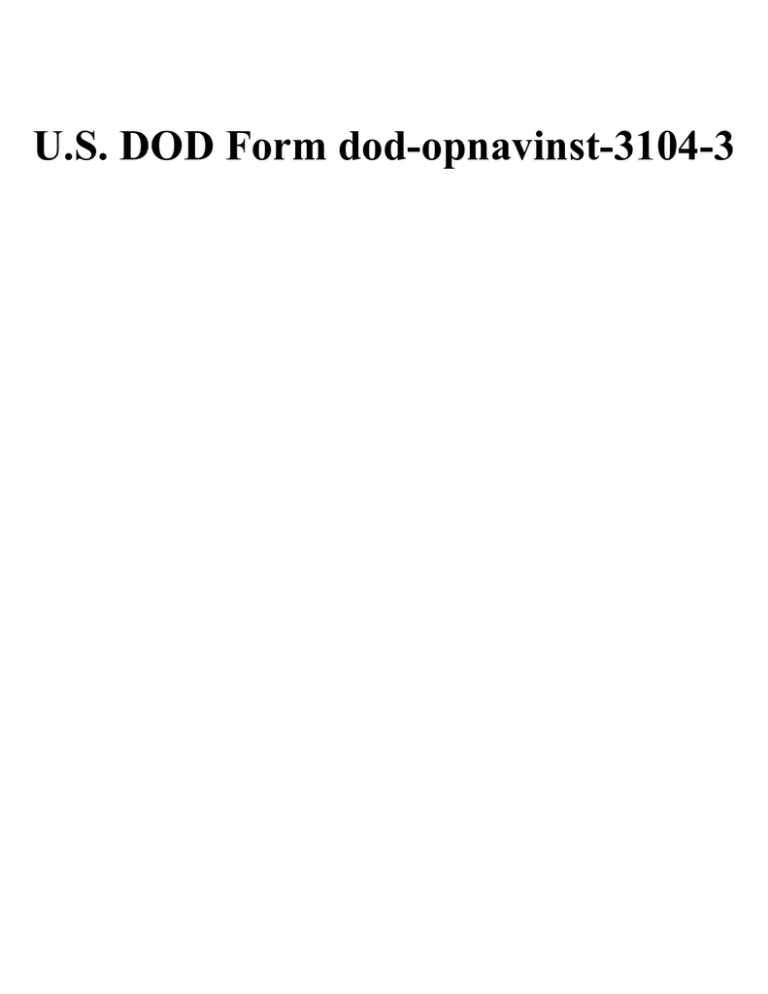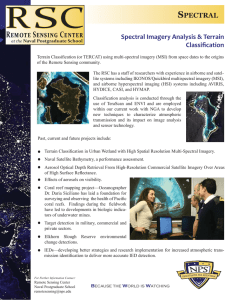U.S. DOD Form dod-opnavinst-3104-3
advertisement

U.S. DOD Form dod-opnavinst-3104-3 DEPARTMENT OF THE NAVY OFFICE OF THE CHIEF OF NAVAL OPERATIONS 2000 NAVY PENTAGON WASHINGTON, DC 20350-2000 OPNAVINST 3104.3 N09C1 15 APR 2002 OPNAV INSTRUCTION 3104.3 From: To: Chief of Naval Operations All Ships and Stations (less Marine Corps field addressees not having Navy personnel attached) Subj: NAVAL COMBAT CAMERA (COMCAM) PROGRAM POLICY, RESPONSIBILITIES, AND PROCEDURES Ref: (a) (b) (c) (d) (e) OPNAVINST 3104.1 OPNAVINST 3501.320A (NOTAL) SECNAVINST 5720.44A DODD 5040.4 of 30 Sep 96 (NOTAL) DODD 5040.5 of 29 Aug 95 (NOTAL) Encl: (1) Navy COMCAM Procedures (2) Visual Information (VI) Definitions 1. Purpose a. To implement the Navy COMCAM Program established in reference (a). b. To further define policy, operational doctrine and assign responsibilities for the planning and execution of the Navy COMCAM mission in support of fleet and joint operations under reference (a). c. To specify readiness, resources and equipment requirements naval COMCAM forces must maintain. 2. General a. Fleet Combat Camera Units are organized, expressly trained and equipped to provide rapid deployment COMCAM assets to support military exercises, operations, and emergencies of the operating forces. This includes providing real-time electronic imaging capabilities to document force deployments and activities of the Navy, and when tasked, other services, before, during and after military engagements. OPNAVINST 3104.3 15 APR 2002 b. The Assistant Secretary of Defense (Public Affairs) (ASD[PA]), in accordance with DOD Instruction 5400.14, “Procedures for Joint Public Affairs Operations,” of 22 January 1996 (NOTAL), provides policy guidance for the employment of joint combat camera teams and the distribution of their products. Reference (a) and this instruction implements these policies and procedures for the U.S. Navy. c. The success of COMCAM depends on two primary factors, timely access to areas of operation, and the timely exploitation of collected imagery. Regardless of classification or sensitivity, operational events must be visually documented as they occur. COMCAM visual records are a vital and often only source of operational and technical information for decision­ making at all levels, historical documentation, public affairs and other Navy mission purposes. d. COMCAM imagery is a valuable decision making tool for Fleet Commanders in Chiefs (CINCs), Naval Operating Forces Commanders and Combatant Commands. Additionally, COMCAM imagery is also a valuable tool for informing the public. Therefore, this imagery is available simultaneously to: (1) Secretary of Defense (2) Chairman, Joint Chiefs of Staff (CJCS) and the Joint Staff. (3) Secretary of the Navy (4) Chief of Naval Operations (5) Combatant Commands. (6) CINCs of Joint Task Forces, Functional Component Commands and Service Components. e. Official visual information documentation is used for operational and combat support as well as public affairs purposes. It is an essential aspect of significant operations, exercises and evolutions. Such documentation provides a one­ time visual record of Navy and Marine Corps participation in significant and often historical events and is used in numerous ways. f. Use of combat documentation for public affairs purposes is especially important when news media representatives 2 OPNAVINST 3104.3 15 APR 2002 themselves are not on the scene or are delayed in reaching the combat area. g. Operational commanders should not confuse combat documentation with “press photography” or restrict official photographers from key events, because the events are “sensitive” or because the resultant visual material may reveal classified information. Documentation often yields intelligence on which operational decisions are made. Moreover, in the public arena, adversaries have been known to manipulate the media through carefully-timed release of biased stories. Without combat documentation, leaders and spokespersons are often left to counter the propaganda with words only. h. The Joint Combat Camera Center (JCCC) is the official central reception center for all Combat Camera still and video imagery. The JCCC quickly processes and distributes COMCAM imagery to key users in the Pentagon, National Capital Region, and Unified Commands. The JCCC ensures that only cleared imagery is released to the public. 3. Applicability and Scope. This instruction applies to the Naval Operating Forces. The scope of the Navy COMCAM program includes still and motion imagery supporting military operations and the processes and resources that support the program. This is a new instruction and should be read in its entirety. 4. Definitions. See enclosure (2). 5. Mission. The mission of Navy COMCAM is to provide the Navy, the CJCS and the Unified Combatant Commands with a directed imagery capability in support of operational and planning requirements during worldwide crises, contingencies, exercises, and wartime operations. 6. Policy a. Navy COMCAM resources shall be maintained by the Naval Operating Forces to provide rapid deployment COMCAM force packages in accordance with the Joint Operation Planning and Execution System (JOPES), and identified by Unit Type Codes (UTCs) specified in reference (b) and in appendix A to enclosure (1), to support all phases of military exercises, operations and emergencies. b. COMCAM responds to tasking for Joint Operations initiated by the Joint Staff, Supported Combatant Commands and 3 OPNAVINST 3104.3 15 APR 2002 their component commanders via the appropriate Fleet CINC. enclosure (1)). (See c. COMCAM responds to tasking for Navy operations, exercises, and contingencies via the appropriate CINC. (See enclosure (1)). d. Original COMCAM imagery will be forwarded to the Navy Component Accessioning Point in accordance with reference (a) and the Imagery Management instruction authorized by OPNAVINST 3104.1. e. Exploitation of COMCAM imagery shall be prioritized to support the local commander and each echelon of command in turn. Within the limits of technology, COMCAM imagery will be made available simultaneously to: on-scene commanders; Joint Task Force (JTF) Commander; Supported Combatant Command; Joint Chiefs of Staff (JCS); Joint Staff; Military Services; and Public Affairs. f. Each command element shall be aware that other echelons have a comparable need for immediate access to COMCAM imagery to support their respective mission objectives, which include briefs, after-action requirements, historical records, and training. COMCAM imagery is also used to support public affairs, intelligence, historical documentation, information warfare (IW), training and other significant objectives. g. Still and motion imagery, and captions produced by combat camera teams will have security classifications established and controlled at the source in accordance with DOD Directive 5200.1, “DOD Information Security Program,” of 15 December 1996 (NOTAL), and will be reviewed for public release in accordance with reference (c). h. Per reference (d), the Joint Combat Camera Center (JCCC) shall serve as the central DOD reception and distribution center for all COMCAM and Joint Interest Imagery. i. The JCCC distributes imagery to the Secretary of Defense, Joint Staff, Military Services, the Office of the Assistant Secretary of Defense (Public Affairs) (OASD (PA)), Unified Combatant Commands, Defense Agencies, and other authorized Agencies. All COMCAM imagery, including imagery not cleared for release, shall be forwarded to JCCC via the most expedient means. 4



